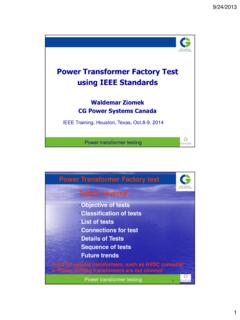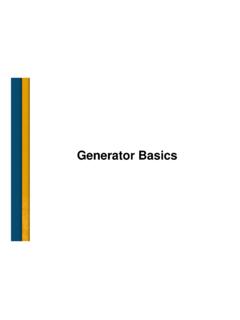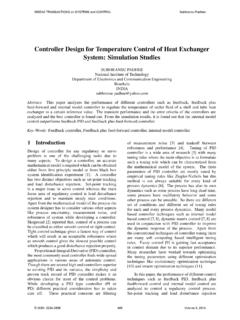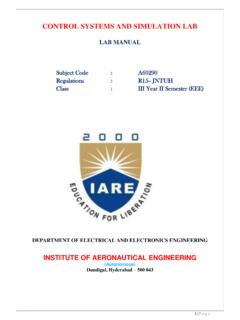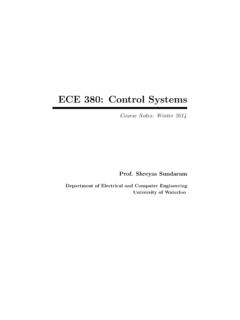Transcription of FUNDAMENTALS OF TURBINE/ GENERATOR SpEED CONTROL
1 O promote a better under-standing of industrial tur-bine/ GENERATOR SpEED CONTROL , the FUNDAMENTALS of droop and isochronous TURBINE/ gen-erator CONTROL are discussed via graphical examples for typical industrial islanding applications with bus-connected generators. a mathematical analy-sis of several examples illustrates the validity of a practical graphical approxi-mation approach. By comprehending these fundamental concepts, industrial application engineers can more thoroughly investigate advanced governor CONTROL topics, such as isochronous load sharing with communication lines between governors, manual operator CONTROL of multiple generators, and load sharing via automatic power-management $ 2013 IEEETBY ROY E.
2 COSS , JR., MICHAEL D. ALFORD, MASOUD HAJIAGHAJANI, & E. ROY HAMILTOND igital Object Identifier of publication: 29 April 2013 FUNDAMENTALS oF turbine/ GENERATOR SpEED ControlA graphical approach for islanding applications artvilleIEEE Industry ApplIcAtIons MAgAzInE july|Aug 2013 IEEE Industry ApplIcAtIons MAgAzInE july|Aug 2013 Outline Simplified block diagrams with sum-ming points show basic TURBINE/ gener-ator governor concepts of droop and isochronous CONTROL (Figure 1). Graphi-cal examples of droop and isochronous governor CONTROL are provided to pro-mote a better understanding of typi-cally encountered industrial islanding graphical approach discussions begin with isochronous CONTROL for one GENERATOR operating independently.
3 A two- GENERATOR isochronous discussion illustrates why operating two genera-tors in independent isochronous gover-nor CONTROL mode is not recommended. Next, one GENERATOR is operated inde-pendently in droop mode, showing the resulting frequency change as load is applied; additionally, this one genera-tor governor droop example shows the effect of changing the no-load frequency (NLF) above and below rated fre-quency. two paralleled GENERATOR examples follow with identical generators operating with the same percent droop; the resulting system frequency is shown when the NLF is the same for both generators and also when the two generators have different computations are included to illustrate that the graphical analysis and the analytical computations provide approximately the same results.
4 Additional graph-ical illustrations show combined isochronous and droop operation and the change in power output as the droop line is shifted. Governor dynamic response capability limit discussions are beyond the scope of this article but are available in [1].to better focus on the real power aspects related to gov-ernor actions, automatic voltage regulator (aVr) consider-ations are not included in this article; however, a future article with advanced governor CONTROL strategies will include aVr Governor SpEED CONTROL Droop and IsochronousDroop and isochronous CONTROL are two fundamental methods of turbine/ GENERATOR governor SpEED CONTROL . Droop CONTROL is a commonly implemented indepen-dent governor SpEED CONTROL method because it achieves stable electrical power system operation with multiple islanding system generators.
5 A very rudimentary expla-nation of droop CONTROL is that an increase in megawatt power loading results in a linear decrease in SpEED , cor-responding to the percent droop selected and NLF; this is described in more detail later in the article. It is imperative that droop CONTROL is well understood before proceeding to more advanced governor CONTROL con-cepts; therefore, droop CONTROL is the primary focus of this the word isochronous is applied to turbine gov-ernor SpEED CONTROL , it means that changes in TURBINE/ gener-ator megawatt power loading result in no final SpEED change from a set reference; to accomplish this as load increases or decreases, immediate SpEED corrections via the fuel valve are made.
6 Stable operation with this type of governor CONTROL has been applicable to single islanding GENERATOR applications. although certain modern governors per-mit multiple bus-connected islanding generators to operate in isochronous load sharing via load-sharing lines, this CONTROL system strategy is considered an advanced type and is beyond the scope of this article. However, the authors plan to discuss isochronous load sharing and other advanced industrial turbine/ GENERATOR CONTROL system strategies in a future 2(a) is an example of a sim-plified turbine/ GENERATOR governor CONTROL system that is the reference system diagram for the discussions here. Figure 2(a) shows a modern, simplified electronic governor CONTROL system with selectable droop/isochro-nous governor CONTROL .
7 Voltage transformers, current transformers, and a turbine/ GENERATOR SpEED sensor (tachometer) provide basic inputs to the modern elec-tronic governor so that a selected fundamental CONTROL strategy (droop or isochronous) can be implemented. as indicated, the governor controls the turbine mechanical fuel valve so that the turbine can provide the GENERATOR megawatt output required by the electrical 2(b) shows a simplified block diagram of the governor SpEED summing point for basic isochronous con-trol. the mechanical SpEED is measured by electrical/elec-tronic SpEED transducers, converted to a usable format, and compared at the summing point with the isochronous SpEED reference (typically 60 or 50 Hz for industrial islanding systems).
8 Deviation from the SpEED reference results in a fuel valve correction to adjust the TURBINE/ gen-erator frequency output until the system frequency is maintained at the SpEED reference and the summing point difference is theoretically zero. as load demand varies, sys-tem frequency is maintained as turbine/ GENERATOR SpEED corrections are made, and turbine/ GENERATOR power output provides the required load megawatt power output; this is isochronous SpEED CONTROL with the purpose of maintaining G2G1 The bus-connected islanding STABLE opErAtIon wIth THIS TYpE OF GOvERNOR CONTROL HAS BEEN AppLICABLE TO SINGLE ISLANDING GENERATOR Industry ApplIcAtIons MAgAzInE july|Aug 2013 constant presettable SpEED as the load mW increases or decreases.
9 This is a typical CONTROL strategy for a stand-alone, one- GENERATOR islanding 2(c) shows a simplified block diagram of the gov-ernor SpEED summing points for basic droop CONTROL , , one summing point for SpEED comparison summation and a separate summing point for megawatt power comparison summation, so that an increase in load mW results in increased fuel to the turbine and a linear decrease in turbine SpEED based on the percent droop setting and NLF. as power must be measured, voltage and current transformer inputs are needed. Droop has been a typical governor con-trol strategy when connecting to a utility infinite governor CONTROL FUNDAMENTALS enables the application engineer to better comprehend governor CONTROL methodology during factory acceptance testing, ini-tial commissioning and startup activities, and operational and maintenance conditions.
10 The following discussions promote a better understanding of droop and isochronous governor CONTROL funda-mentals for one- and two- GENERATOR appli-cations. With this increased application background, the authors anticipate that when turbine/ GENERATOR megawatt opera-tion deviates from the expected, the oper-ating conditions can be more readily understood, and appropriate corrective action can be taken by facility Operation ExamplesConsider an islanding electrical power system with one turbine/ GENERATOR and associated governor operating in iso-chronous mode. Figure 3(a) is a steady-state graph of the GENERATOR megawatt output power versus frequency with an isochronous governor CONTROL strategy operating at 60-Hz frequency reference, ignoring response to transients.
